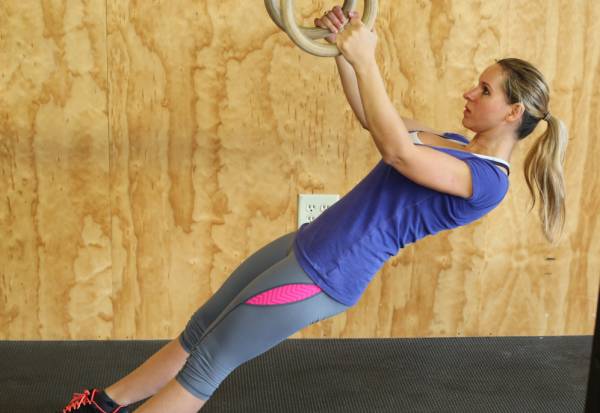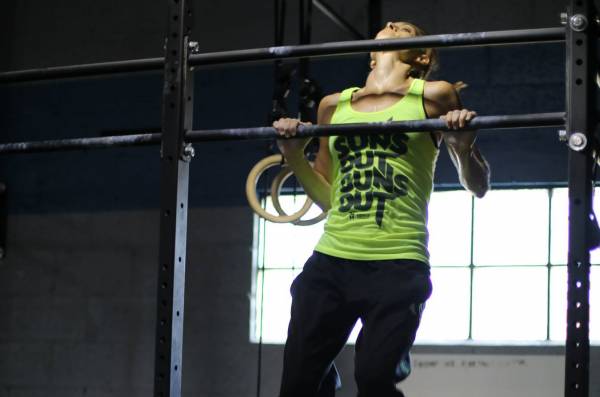I have a rule when working with new athletes on pull ups. I ask them to “just say no” to bands. Bands are much like drugs in that once a person gets hooked, it is difficult to get them off.
You may have inadvertently gotten yourself hooked on these little strips of rubber with the best of intentions. But I’m going to explain the three reasons you need to break this habit, and how doing so will help you and your pull ups be stronger in the end.
RELATED: 10 Ways to Repair and Strengthen Your Pull Ups
Bands Provide Inconsistent Assistance
The intent of banded pull ups is a good one. It provides assistance to the athlete so he or she can get the chin or chest to the bar. It is a cheap alternative to the expensive machine that provides a counterweight applied to the person’s legs or knees to assist him or her (sometimes called a Gravitron machine). But as the cliché goes, you get what you pay for.
The banded pull up is like a spotter that is sometimes overly attentive and at other times not paying attention at all. Imagine someone spotting you on a bench press and at the bottom position, he yanks on the bar for you. At the top position, he is off checking his phone. The banded pull up is similar in how it assists people.
“The banded pull up is like a spotter that is sometimes overly attentive and at other times not paying attention at all.”
The Solution – Get a Spotter
If you want to perform assisted pull ups, get a spotter. A spotter will be able to provide more optimal assistance by giving you enough assistance in your sticky spots so you can finish the movement and gain strength. In many group classes, it might be difficult to have spotters, but a team workout where one member is working and the other is spotting could be an alternative.
Bands Should Only Complement the Resistance Curve
In compensatory acceleration training of the squat, the athlete uses bands attached to the ground to provide greater resistance in the top part of the exercise where the movement is easier. With this technique, we learn to accelerate through our lifts, which helps us lift heavier things. In banded pull ups, we are doing the opposite by giving assistance in all the wrong places.
RELATED: Compensatory Acceleration Training: Speed Up Your Strength Gains
The bottom of the pull up is where we need to start from a dead stop. We have no momentum and our leverage is at its worst. Sounds like a perfect place to help, right? Well, yes – but only if you don’t want to build strength. The places we struggle are where we build the most strength. The bottom of a banded pull up is like a jumping device for babies. It might be entertaining and fun, but it might not be the optimal way to build strength.
Many people are as happy as infants when they start doing banded pull ups. But you should treat them like a highly addictive drug and stay away.
The Solution – Do Jumping Pull Ups
You can break through strength plateaus by getting stuck in the toughest positions. We do box squats or pause squats to practice being stuck in the bottom. Thus, I would suggest jumping pull ups, which simply involve jumping up on the bar and slowly lowering yourself down. The key is in resisting on the way down.
“A more advanced person could do pauses at his or her sticky points. This controlled and slow descent will build pull up strength much faster than bands.”
In a workout, you can figure out how long each descent should be and shoot for time on the way down as the goal (e.g., each round will have five reps of two seconds on the way down). Don’t count reps where you don’t hold for the specified time. It will be much better for you in the long run if you don’t rush on the way down. A more advanced person could do pauses at his or her sticky points. This controlled and slow descent will build pull up strength much faster than bands.
Get Rid of the Bands
The third reason is a sub-reason of the last one. If you are not creating strength in the right part of the strength curve, then you will have a difficult time getting off bands. Many people talk about a progression of going from greater resistance bands to lighter bands. But our body takes a long time to adapt to the dead weight at the bottom of the pull up and the bands are an inefficient way to build strength. As a result, I have seen many people a year into their training still doing pull ups on bands.
The Solution – Grease the Groove
As a person attempting your first pull up, more volume can be helpful. A greasing-the-groove type of program might be perfect for some. Every hour or so, do a few jumping pull ups with a slow descent. If you can’t do them throughout the day, do them everyday. A low daily volume over frequent days adds up to impressive gains.
Ring Rows Are a Better Alternative for Beginners
Ring rows are great for a beginning athlete. The movement is easily scaled by moving the feet forward or backward and/or bending the knees.

In many aspects of CrossFit and other conditioning programs, we do a lot of pressing movements (overhead presses, bench press, push ups). The pull up winds up being one of our only pulling movements. The pull up is great, but it is also good to change the angle of the pull to build up the muscles of the back, the rotator cuff, and around the scapula. I recommend ring rows or some type of bent-over row for everyone in order to create balance in muscular development and to support shoulder health.
Another similar option is to place a bar in the rack. You can then do pull ups with your feet outstretched in front to provide assistance (i.e., a nice tight plank with the feet taking away some of the weight of the body). Some people also know this as an Australian pull up (because you’re “down under.”)
“I recommend ring rows or some type of bent-over row for everyone in order to create balance in muscular development and to support shoulder health.”
Wrap Up
As the saying goes (I may have it slightly wrong), friends don’t let friends do banded pull ups. Bands are like drugs. Please don’t get hooked on them.
The only time a band would be appropriate is if the bands are attached to something on the floor and are providing resistance. That is a great use of bands as it gives the most resistance at the top of the movement and teaches explosiveness on the way up.
But if your goal is to build strength for strict pull ups, I recommend ring rows and jumping pull ups with slow descents. These exercises will build strength much more quickly for the pull up.
REALTED: CrossFit Pull Ups: Which Came First? The Strict or the Kip?

Further Reading on Pull Ups
- Melody Schoenfeld wrote a great article on tips for getting better at strict pull ups.
- Amber Larsen, one of my favorite Pulse Beat Fit authors, wrote this piece on how bands hold people back.
Photos courtesy of CrossFit Empirical.






